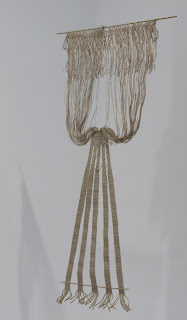It started on a visit to Tate Modern to see a completely unconnected exhibition. With time to spare before my alloted slot I decided to wander the galleries of the permanent collection, and was greeted and rewarded in the first room on the second floor by the spectacle of a most intriguing threaded construction. It was Lenore Tawney's Queen, an imposingly large, almost sculptural, woven, fibre-art construction. The sophisticatedly complex Queen, was accompanied by a couple of Tawney's drawings which fascinated me as I recognised an immediate connection in her drawings and the linear mathematical models based on geometry that had inspired and informed my own Aeolus series (here). Tawney's drawings were also strongly reminiscent of those of visionary and healer Emma Kunz, seen at The Serpentine Gallery (here). Then as chance would have it I saw a two-part exhibition devoted to Tawney was being hosted at Alison Jacques Gallery which I'd visited for other exhibitions of fibre art previously on two occasions earlier last year (here), and (here). Upon further investigation I also discovered that Tawney had exhibited with Sheila Hicks in group shows of fibre art on two occasions in 1963 and 1964. There was a nice serendipitous synchronicity at play here. Tawney became an infuential figure in the development of fibre art after having studied at Chicago Institute of Design under László Moholy-Nagy, where she met cubist sculptor Alexander Archipenko. Tawney travelled extensively then moved to New York where she associated with Minimalist artists such as Ellsworth Kelly, Robert Indiana and Agnes Martin. Tawney began weaving in 1954 and from the beginning combined traditional methods with experimental techniques to create painterly effects which were initially rejected by both the art and craft communities. Her revolutionary experimental works which at times ignored the rigid restrictions of the loom to create sculpturally freer forms, encompassed both disciplines and went on to be accepted and revered by followers of her works across all spectrums of the art/design world. I admire the diversity in Tawney's work in which some pieces have a solid presence being thickly woven, structural totems, whereas others are fragile, diaphanous webs, criss-crossed with contrasting trails of thicker thread. They are an exquisite series of tangles, twists and knots whose forms echo and resemble architectural elements. On display at both parts of these exhibitions at Alison Jacques are other aspects of Tawney's oeuvre such as those intriguing linear ink drawings on graph paper which she would go on to recreate three-dimensionally, and some delicate layered collages which display the influence of the spiritual, written word and poetry on her art.
~ Lenore Tawney - Part One ~
~ Lenore Tawney - Part Two ~
Becoming hooked on Tawney's fibre art I had to return to Alison Jacques for a further fix. The second part of the exhibition was a much more spartan affair. The main exhibition space was bare except for Tawney's large, dramatic, Cloud installation which features thousands of threads individually knotted and inserted into a linen background hung from the ceiling. It was a theatrical statement which recalled the immersive thread installations of Chiharu Shiota (here, and here), with its ethereal cascading field of suspended glittering threads. An installation as dramatic as this demanded the space of a room of its own. I just wanted to walk slowly through it, to feel the individual threads caressing my face and hands. The second, smaller exhibition space also featured more of Tawney's linear drawings. and a series of her boxed constructions punctuated by thread, that displayed her love of poetry and arcane writings with collaged text, and two smaller versions of Cloud. What I was most intrigued to see though in this smaller exhibition space were the perspex boxes in which she interpreted and developed these linear drawings three-dimensionally into physical spatial works. I thought these were particularly wonderful. Both exhibitions were a great opportunity for me to accquaint myself with Tawney's ouevre which had been previously unfamiliar to me. The one thing that shone through to me was her dedication to her practice, and her single-minded devotion to the furthering of the art of weaving and textiles. I look forward to discovering more in my ongoing investigations.


















































No comments:
Post a Comment